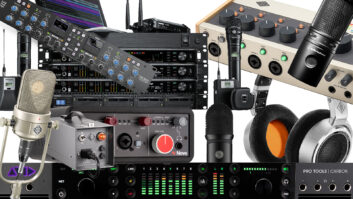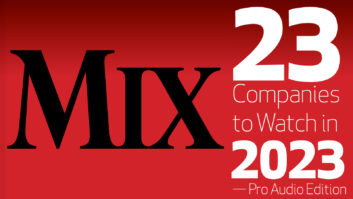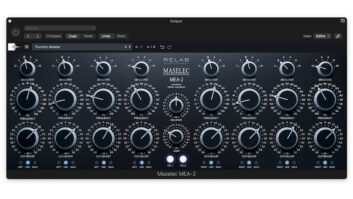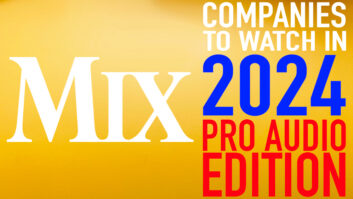Noted TV soundtrack performer/composer and longtime Pro Sound News reviewer Rich Tozzoli finishes his look back at the gear that entered his studio this year and never left: “Over the past year, I discovered many new products through the review process that impressed me enough to buy and add them to my daily workflow. Let’s examine some of the review gear that found its way into my studio since late 2016 and discuss just how much of a difference it makes to my productions overall. These are listed in no particular order.”
EASTWEST MIDI GUITAR SERIES

EastWest MIDI Guitar Series
This is the newest addition to my production workflow—a collaboration between virtual instrument-makers EastWest and Fishman with their TriplePlay Wireless MIDI Guitar Controller. Wow, I have to rethink what I just said, because I never really liked MIDI guitar before, and that comes from a guitar player!
The Fishman TriplePlay is an easy to install, next-generation wireless MIDI guitar system that integrates perfectly with the newly created East-West MIDI Guitar Instruments. It works via wireless USB receiver and can output the synth alone, guitar alone or mix. The five new East-West releases have been optimized to work with the waveforms from a guitar’s vibrating strings, and it loads the instruments on all strings at the same time, which apparently saves computer processing. The EastWest MIDI Guitar Series includes Orchestra, Ethnic and Voices, Soundscapes, Guitar and Bass, and Keyboards and Percussion volumes.
I installed the system onto one of my Telecasters in just a few minutes, loaded in the software (bravo to Fishman for such an easy install), made a few small tweaks to the sensitivity and I was off and running in MIDI guitar-land.
You may need a little time to get used to how this works, especially since it’s a completely different approach and feel than a keyboard—which, creatively, is a good thing. The tracking, which is quite good for a MIDI guitar system, is fluid and plays the guitar series of instruments especially well, including pitch bends, slides and even harmonics. Some patches, especially the non-guitar focused ones, don’t trigger as well as others, with the more ‘attack’-based sounds working the best. It’s a trial-and-error learning experience, but it’s unquestionably the most effective MIDI guitar system I’ve used to date. To me, what made it so useful is I could play string lines on my guitar that there’s no way I could do on keyboards. Then, digging into some of the interesting soundscapes and ethnic instruments (such as Baritone VLN Exp Vib), I was inspired to immediately start writing some cues with it, which is exactly what you want. I also felt the acoustic guitar sounds were exceptional—and I have some nice acoustics!
Note that you can trigger any MIDI instrument with the Fishman system, not just EastWest libraries. Included in the installation pack are free downloads of PreSonus StudioOne OEM, Kontakt Elements and Guitar-Rig LE, IK Multimedia SampleTankXT and Notion Music Progression 2. However, it’s smart for Fishman and EastWest to team up and create a package geared specifically to guitar players who want to trigger software instruments. Stay tuned for more updates on this entire system as it works its way further into my studio.
LINE 6 HELIX GUITAR MULTIEFFECTS FLOOR PROCESSOR

Line 6 Helix Guitar Multi-effects Floor Processor and Eventide H9 Harmonizer Multi-effects Pedal
Built like a tank for both studio and road work, using Helix is what it took to change my mind about hardware guitar processors. As a longtime tube amp collector and lover of guitar plug-ins, it was nice to get my hands on a box that delivered across the board as far as sounds, I/O, routing and integration goes. Inside there’s over 200 amps, cabinets, mics and effects, and on top, there’s capacitive touch-sensitive switches, 12 touch-sensitive footswitches, a 6.2-inch LCD display and 10 inputs and outputs on the rear.
While they do make it easy to navigate directly on the hardware, the Helix Editor is how I really dig deep into this unit. Running on my Mac (it also runs on PC), it allows me to control all of the amps, cabinets and stomp pedals to quickly get what sounds I need. Helix can go from screaming ENGL amps to classic Fenders, and it’s become an integral part of my guitar production path. I often take it to studio sessions and run miked-up amps like my Mesa Boogie MKIV on the left and Helix on the right, just to give me a big, wide stereo guitar sound.
EVENTIDE H9 HARMONIZER MULTIEFFECTS PEDAL
While I do use Eventide software quite a bit—especially Black-hole reverb—the H9 takes my guitar processing to another level. Sometimes I will plug directly in and run the stereo out into my preamps, but mostly I hook it up to the effects loop of my Line 6 Helix, delivering some seriously cool sounds (I often run two at a time).
What the H9 allows me to do is basically increase the overall depth of guitar sounds, using the lush dense reverbs, delays and choruses. However, it also has some cool edgy distortion sounds and, as you might expect from Eventide, top-notch pitch-shifting. I also plug my analog synths into it for some nice ambient soundscapes. H9 can run all of Eventide’s stompbox effects and features Stereo I/O and MIDI I/O, as well as aux switch and expression pedal inputs.
Since it can connect via Bluetooth to the free editor app on my iPhone, I control it either that way or through the H9 desktop software.
SENNHEISER HD 800 S HEADPHONES

Sennheiser HD 800 S Headphones
Certain headphones just feel right when you put them on. The Sennheiser 800, which is hand-assembled in Germany, has that presence. Quite large in size due to the fact that they use the largest transducers ever used in headphones, they are still lightweight at just 11.6 oz. The 56 mm transducer is housed in stainless steel while the rest of the design uses aerospace-grade materials. Even the XLR-4 cable feels different, coming in at 11.5 feet with the attached quarter-inch plug.
I found it best to push the HD800 in tightly on my head. It’s an amazingly comfortable “big headphone,” and, due to the design, it feels like you’re listening to speakers, and this is far more than any other set of headphones I own. It is one of the few—if not only—headphone sets that I can take on and off, compare to my speakers, and then say, “wow, that’s spot on,” no doubt due to its 4 Hz to 51 kHz frequency-range specs and the fact that the drivers direct sound to the ear at an offset angle. I find I use them to make decisions on not only overall balances, but critical details like reverbs, EQ and dynamics. Also, I can wear these for long periods of time with little to no fatigue, which is a small but important factor. Note, however, that I use them only for mixing and not for tracking as they are an open-back design. These are audiophile-grade headphones with an amazingly natural soundfield with no hype.
MANLEY FORCE FOUR-CHANNEL MICROPHONE PREAMP
I first got turned onto this unit during an Omar Hakim tracking session, where we put it through its paces. Once we determined that, “oh yeah, it’s a winner,” I had to have one. On my desktop, the Force sits to the left of my screen; I can reach over and access the meaty Input Level knobs (which just feel so right). It’s packed with four 12AX7WA dual triode vacuum tubes, a beefy high-voltage power supply and balanced transformer-coupled XLR mic inputs on the back with 1250 Ohm input impedance. I appreciate the pure simplicity of this unit, where besides the big knobs, there’s nothing but Hi/Low, Flat/120 Hz roll-off, Phase and 48 V phantom buttons, and a seven-segment LED peak meter, as well as four quarter-inch Hi-Z input jacks.
Since I run a handful of analog synths and a Line 6 Helix, the Force makes the perfect preamp to pair up with them. With the analog synths, I want to feel the depth of the filters, and the Force has the right attitude and gain (note that there’s an additional 10 dB of Gain available via internal jumpers). With the Helix, it’s an all-digital box, so I want to use the Manley’s tubes to do what they do best: make things warm and round. What I like about the Force is that it adds character, feel and attitude to whatever you plug into it. That’s why it has an important place in my production chain.
Rich Tozzoli is an award-winning, Grammy-nominated producer, engineer and composer for programming such as FOX NFL, Pawn Stars, Duck Dynasty and Oprah & Deepak Chopra.
richtozzoli.com






